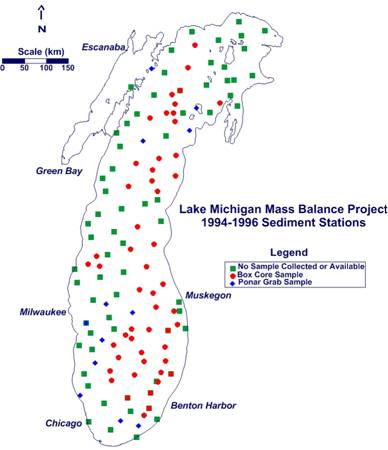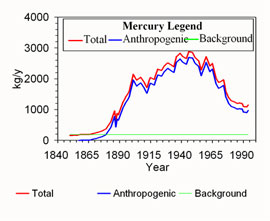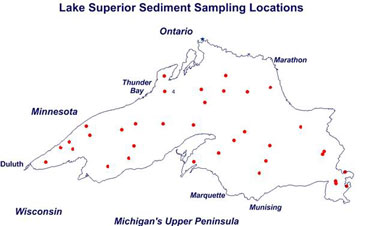Chemical Analyses
Summary

Sediments were collected by gravity core from 74 locations in Green Bay, Lake Michigan. Surficial sediments (0-1 cm depth) from these stations were analyzed for total mercury for the purpose of describing the horizontal variation of mercury in Green Bay sediments, estimating mercury fluxes to surficial sediments, and identifying potential sources of mercury. With concentrations ranging between 0.006 and 1.0 mg/kg, the surficial sediments had a mean mercury concentration of 0.36 mg/kg. The median concentration was 0.28 mg/kg. Surficial sediment mercury concentrations were highest along the eastern shore between the cities of Green Bay and Sturgeon Bay. Elevated concentrations were also found near Escanaba and west of Chambers Island. Lowest concentrations were found north, south, and west of Washington Island and near the Little Suamico River. Mercury fluxes ranged between 0.03 and 100 ng/cm2/y, with a mean of 20 ng/cm2/y. Only 14% of this flux is delivered by regional atmospheric sources. With the Fox River being the dominant contributor, the majority of the total mercury flux to the bay is delivered by the bay’s rivers.

Between 1994 and 1996, sediment samples were collected from 118 stations in Lake Michigan. Samples were collected using both a box corer and a PONAR grab sampler. Samples were collected for the purpose of describing the current horizontal variation of mercury in surficial sediment and comparing current concentrations and fluxes to historic data. This work includes the first description of the horizontal variation of mercury fluxes to the lake’s sediment. It also provides a more recent description of the horizontal distribution of mercury concentrations within the lake’s sediments. For the 118 sites sampled and analyzed, the surficial sediment mercury concentration averaged 78 ng/g and ranged between 2 and 260 ng/g. Concentrations were highest in depositional basins and produced a horizontal pattern that conformed to the lake’s bathymetry. The horizontal distribution of mercury fluxes did not conform to the bathymetry. Instead maximum fluxes were shifted toward the southeastern shore. Fluxes to and concentrations in each depositional basin’s surficial sediments were not significantly different from one another. Fluxes averaged 7.2 ng/cm2/y and ranged between 0.85 and 32 ng/cm2/y. Regional atmospheric fluxes account for roughly 50 percent of the total mercury flux to surficial sediments.

Samples of opportunity from Pb-210 dated sediment cores collected from Lake Michigan between 1994 and 1996 were analyzed for mercury. The storage of both anthropogenic and total (post-1850) mercury in the lake is calculated to be 186 and 228 metric tons, respectively. By setting the sum of mercury stored in a representative core equal to the mercury storage within the entire lake, the time variation of annual mercury loading to the lake is calculated. The modern (1980-2002) mercury flux to the lake represented by the surface of the core at the time of collection in 1994 was 21.4 µgm-2y-1. The preindustrial flux (≤1850) was 3.09 µgm-2y-1, and the peak flux in 1946 was 53.3 µgm-2y-1. These yield modern and peak enrichment factors of 6.92 and 17.2, respectively. Modern fluxes exceed published atmospheric deposition estimates and, therefore, include both terrestrial point sources as well as atmospheric deposition. The modern net mercury load to the lake’s sediments was 1157 kg/y in 1994. The atmosphere is estimated to contribute 91% of this load to the lake.

Sediment cores were collected in 1994 and 1995 using a box corer, sectioned at 1 cm intervals, stored frozen, freeze-dried, dated by the NOAA Great Lakes Environmental Research Laboratory, and analyzed for lead by USEPA. In high sedimentation rate regions, maximum total lead concentrations (130-140 ppm) occurred in 1960. In southern basin cores, maximum total lead concentrations (150-180 ppm) occurred between 1953 and 1971. In northern basin cores, maximum total lead concentrations (150-200 ppm) occurred between 1956 and 1965. Lead concentrations in the high sedimentation rate cores correlated with socio-economic events, especially consumption of leaded gasoline. Cores from offshore depositional basins were less sensitive to anthropogenic inputs of lead; however, the lead profiles correlated with population growth, an indicator of anthropogenic lead load, in the Lake Michigan region. Mean background concentration for all cores was 15 ppm (standard deviation ± 2 ppm). Background concentration was exceeded between 1852 and 1907.
Publications
Marvin, C. H., S. Painter, and R. Rossmann. 2004. Spatial and temporal patterns in mercury contamination in sediments of the Laurentian Great Lakes, Environmental Research 95:351-362.
Marvin, C., S. Painter, D. Williams, V. Richardson, R. Rossmann, and P. Van Hoof. 2004. Spatial and temporal trends in surface water and sediment contamination in the Laurentian Great Lakes. Environmental Pollution 129:131-144.
Rossmann, R. 2002. Lake Michigan 1994 - 1996 surficial sediment mercury. J. Great Lakes Res. 28(1):65-76.
Rossmann, R. and D. N. Edgington. 2000. Mercury in 1987-1990 Green Bay, Lake Michigan surficial sediments. J. Great Lakes Res. 26(3):323-339.
Rossmann, R. 2000. Mercury in and fluxes to Lake Michigan surficial sediments. In: 11th Annual International Conference on Heavy Metals in the Environment (J. Nriagu, Editor), Contribution #1126. University of Michigan, School of Public Health, Ann Arbor, MI (CD-ROM).
Reports
Pfeiffer, E. L., B. Raymond, and R. Rossmann. 2009. Standard Operating Procedure for the Analysis of Trace Elements by ICP/MS. LLRS-MET-SOP-025, Revision 1, Large Lakes Research Station, United States Environmental Protection Agency, 32 pp.
Filkins, J. C., R. Rossmann, and B. T. Raymond. 2007. Standard Operating Procedure for Analysis of Sediment Samples for Methyl Mercury. LLRS-MET-SOP-026, Revision 0, Large Lakes Research Station, United States Environmental Protection Agency, 15 pp.
Pfeiffer, E., B. T. Raymond, and R. Rossmann. 2005. Standard Operating Procedure for Microwave Digestion of Sediment Samples for Lead Analysis. LLRS-MET-SOP-024, Revision 0, Large Lakes Research Station, United States Environmental Protection Agency, 24 pp.
McCarty, H. B., K. Miller, R. N. Brent, J. Schofield, and R. Rossmann. 2004. Results of the Lake Michigan Mass Balance Study: Mercury Data Report. EPA-905-R-01-012, Great Lakes National Program Office, United States Environmental Protection Agency.
Parada, L., M. Levine, and R. Rossmann. 2002. Standard Operating Procedure for Analysis of Samples for Total Mercury using the Milestone Analyzer. LLRS-MET-SOP-022, Revision 1, Large Lakes Research Station, United States Environmental Protection Agency.
Rossmann, R. 2000. Standard Operating Procedure for Freeze-Drying Sediment and Biota Samples and Measuring Moisture Content. LLRS-MET-SOP-020, Revision 0, Large Lakes Research Station, United States Environmental Protection Agency.
Presentations
Rossmann, R. 2009. Estimation of a historic mercury load function for Lake Michigan using dated sediment cores. 2009 International Association for Great Lakes Research Annual Conference, 18-22 May 2009, Toledo, Ohio, pp. 191-192 of abstracts.
Rossmann, R. 2008. Investigation of total and methyl mercury in fish and sediment of Lake Michigan. Workshop on Integrating Multimedia Measurements of Mercury in the Great Lakes Region, November 10-12, 2008, La Crosse, Wisconsin.
Rossmann, R. 2008. The use of dated sediment cores to describe the history of contaminant loads to systems: a case study of mercury fluxes to Lake Michigan. 2008 Ocean Sciences Meeting, March 2-7, 2008, Orlando, Florida.
Rossmann, R. 2006. The Sediment Record of Mercury Loads to Lake Michigan. Presented at Michigan Mercury Research Workshop, Michigan Department of Environmental Quality, Romulus, Michigan, June 15, 2006.
Pfeiffer, E., R. Rossmann, L. Parada, and B. T. Raymond. 2005. A preliminary look at lead concentrations in dated Lake Michigan sediment cores. 48th Conference on Great Lakes Research, International Association for Great Lakes Research, Ann Arbor, Michigan, May 23-27, 2005, p. 149 of abstracts.
Rossmann, R., L. Parada, and B. T. Raymond. 2005. Mercury concentrations in dated Lake Michigan sediment cores. Presented at 48th Conference on Great Lakes Research, International Association for Great Lakes Research, Ann Arbor, Michigan, May 23-27, 2005, p. 159 of abstracts.
Rossmann, R., C. H. Marvin, and S. Painter. 2003. A Review of Historical and Recent Mercury Concentrations in Great Lakes Sediments. Presented at Workshop on An Ecosystem Approach to the Health Effects of Mercury in the Great Lakes Basin, The International Joint Commission in collaboration with The Great Lakes Commission, Windsor, Ontario, Canada, February 26-27, 2003, p. 6 of abstracts.
Rossmann, R., K. R. Rygwelski, and J. C. Filkins, 2001. Methyl mercury in Lake Michigan surficial sediments. Presented at the 44th Conference on Great Lakes Research, International Association for Great Lakes Research, Green Bay, Wisconsin, June 10-14, 2001, p. 113 of abstracts.
Rossmann, R. and B. A. Fashbaugh, 2000. Lead, copper, zinc, and cadmium in Lake Michigan surficial sediments. Presented at the 43rd Conference on Great Lakes Research, International Association for Great Lakes Research, Cornwall, Ontario, May 23-26, 2000, p. A-133 of abstracts.
Summary

Persistent elevated mercury concentrations in some species of Lake Superior fish and the general lack of information on mercury storage in and fluxes to the lake’s sediments prompted the analysis of samples of opportunity that were collected in 1983. Results of the analyses support the conclusion that Lake Superior sediments have mercury concentrations above background levels at all sites sampled. For those cores which penetrated the sediment deeply enough (the majority of the cores), background mercury concentrations ranged between 0.016 and 0.048 mg/kg. Mercury concentrations in surficial sediments ranged between 0.027 and 0.96 mg/kg. The maximum mercury concentration found in sub-surface sediments (2 to 20 cm deep) was 6.5 mg/kg. The surficial 20 cm of sediment contained 342 metric tons of mercury of which 51% or 174 metric tons was anthropogenic. The surface 2 cm of sediment contained 29 metric tons of mercury of which 76% or 22 metric tons was anthropogenic. Estimated total mercury fluxes to surficial sediments ranged between 0.1 and 10 ng/cm2/y with a mean of 3.2 ng/cm2/y. Background total mercury fluxes to the lake ranged between 0.20 and 0.72 ng/cm2/y with a mean of 0.48 ng/cm2/y. Estimated fluxes of anthropogenic mercury to surficial sediments ranged between -0.42 and 10 ng/cm2/y with a mean of 2.7 ng/cm2/y. The fluxes reported here are only the second known reporting of mercury fluxes to Lake Superior sediments. The inventory of mercury in the sediments is the first reported.
Publications
Kerfoot, W. C., S. L. Harting, J. Joeng, J. A. Robbins, and R. Rossmann. 2004. Local, regional, and global implications of elemental mercury in metal (copper, silver, gold, and zinc) ores: insights from Lake Superior sediments. J. Great Lakes Res. 30 (Supplement 1):162-184.
Kerfoot, W. C., S. L. Harting, R. Rossmann, and J. A. Robbins, 2002. Elemental mercury in copper, silver, and gold ores: an unexpected contribution to Lake Superior sediments with global implications, in Allan, R. J., A. J. Horowitz, and J. Miller (eds.), Metal mining and the environment. Geochemistry: Exploration, Environment, Analysis 2:185-202.
Kerfoot, W. C., S. L. Harting, R. Rossmann, and J. A. Robbins. 2000. Mercury in metal ore deposits: an unrecognized, widespread source to Lake Superior sediments. In: 11th Annual International Conference on Heavy Metals in the Environment (J. Nriagu, Editor), Contribution #1072. University of Michigan, School of Public Health, Ann Arbor, MI (CD-ROM).
Kerfoot, W. C., S. Harting, R. Rossmann, and J. A. Robbins. 1999. Anthropogenic copper inventories and mercury profiles from Lake Superior: evidence for mining impacts. J. Great Lakes Res. 25(4):663-682.
Rossmann, R. 1999. Horizontal and vertical distributions of mercury in 1983 Lake Superior sediments with estimates of storage and mass flux. J. Great Lakes Res., 25(4):683-696.
Presentations
Kerfoot, W. C., S. L. Harting, J. A. Robbins, and R. Rossmann, 2002. Lake Superior sediments alter the “Old Hg” versus “New Hg” debate, Superior State-of-the-Lake, 22-24 May 2002, Michigan Technological University, Houghton, Michigan.
Harting, S. L., W. C. Kerfoot, R. Rossmann, and J. A. Robbins, 2002. Copper and mercury in Keweenaw Waterway and Lake Superior sediments: ore sources revealed, Superior State-of-the-Lake, 22-24 May 2002, Michigan Technological University, Houghton, Michigan.
Harting, S. L., W. C. Kerfoot, and R. Rossmann, 1999. Mercury in stamp sand discharges: implications for Lake Superior mercury cycling. Presented at the 42nd Conference on Great Lakes Research, International Association for Great Lakes Research, Case Western Reserve University, Cleveland, Ohio, May 14-28, 1999, p. A-42 of abstracts.
![[logo] US EPA](../gif/logo_epaseal.gif)